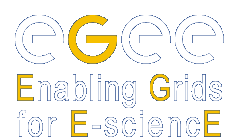Collaborating Projects
Memoranda of Understanding
EGEE is in the process of establishing written agreements in the form of Memoranda of Understanding (MoUs) with a number of collaborating projects. The purpose of these MoUs is to define a framework of collaboration between EGEE and other projects towards common objectives by identifying synergies between their programmes of work and formalising them into joint activites and milestones.
A number of MoUs have been signed or are in the process of being finalised with the following specific objectives:
1. EDGeS - Signed in September 2008
- To enhance the capacities of both EGEE and ESDGeS infrastructures;
- To allow EGEE users access to EDGeS resources;
- To establish an EDGeS Virtual Organisation (VO) within the EGEE infrastructure and allow EDGeS users access to EGEE resources via this VO.
2. GridTalk - Finalised in July 2008
- EGEE will provide and identify content for the iSGTW newsletter.
- EGEE will be featured in the iSGTW/GridCafé resources section, and applications and individuals from the project covered in areas such as the proposed 'Women in Grids' section in iSGTW.
- EGEE sites and applications will be covered by the GridGuide.
- GridCasts will take place from EGEE conferences, with EGEE members blogging or being interviewed from such events.
- EGEE's wide contacts with grid projects across Europe and worldwide will provide GridTalk with access to national and regional infrastructure initiatives.
- GridTalk products will also be promoted to other projects at EGEE conferences to make sure they realise that GridTalk offers useful dissemination channels.
3. EUFORIA - Established in July 2008, Finalised in 2010
- Exploitation by EUFORIA of EGEE technologies through the EGEE Fusion VO which supports the activities of people participating in nuclear fusion applications.
- Increase the impact of the use of grid technologies in the Fusion community and consolidation of e-Infrastructures in Europe.
4. Kazakh-British Technical University - Signed in November 2008
- To create a partnership to help establish a national grid infrastructure in Kazakhstan and its connection to the European grid infrastructure.
5. OGF-Europe - Finalised in December 2008
- To accelerate the development of standards within production grid infrastructures;
- To expose new communities to the capabilities of production grid infrastructures and to gather feedback from their experiences as to how such infrastructures can be improved in the future;
- To organise and disseminate joint events and to disseminate the results of joint initiatives.
6. GENESI-DR - Signed in January 2009
- To demonstrate access to the Earth Science (ES) data integrated in the GENESI-DR Research Infrastructure from the EGEE infrastructure.
- To enable the EGEE ES community and GENESI-DR users to share applications across the two infrastructures.
7. BalticGrid-II - Signed in March 2009
- Ensure provision of regional operational grid support to the Baltic States and Belarus resource centres.
- Support the porting of BalticGrid-II applications to the projects' infrastructures.
- Support the testing of gLite-UNICORE-ARC interoperability solutions from EGEE.
- Support the transition to an operational model based on National Grid Initiatives.
8. SEE-GRID-SCI - Signed in March 2009
- Ensure interoperation of both projects' infrastructures and interoperability of related services towards a sustainable pan-European Grid.
- Support the porting of SEE-GRID-SCI applications to the projects' infrastructures.
- Support the development of application-level services, monitoring and control tools.
- Support the transition to an operational model based on National Grid Initiatives.
9. EELA-2 - Signed in July 2009
- Ensure provision of regional operational grid support and coordinated network support to Latin American resource centres.
- Support EELA-2 development work on gLite components to Windows porting and gLite-OurGrid interoperability.
- Support the porting of EELA-2 applications to the projects' infrastructures.
- Support LA plans in achieving sustainable regional e-Infrastructure.
10. RESERVOIR - Agreed in May 2009
- Explore the scalability and quality of virtualised physical resources achieved using RESERVOIR technology.
- Expand the capacity of physical EGEE resource site with virtualised physical resources.
- Deploy a virtualised EGEE resource site on virtualised physical resources.
11. ETICS 2 - Finalised January 2010
- ETICS 2 shall provide non-exclusive access to its build and test infrastructure in order to build and test the software provided by EGEE.
- ETICS 2 shall provide non-exclusive access to all software tools developed by the ETICS project for use on the ETICS , third party and private infrastructures as necessary.
- ETICS 2 shall provide non-exclusive but privileged access to the support and training services managed by ETICS 2. Requests from EGEE will be treated with higher level of priority than other similar requests within the provisions of the ETICS Service Level Agreement.
- EGEE shall register and maintain one or more projects and any related configuration in the ETICS system.
- EGEE shall use the ETICS tools to execute builds and tests and provide feedback.
- EGEE shall store the build and test artifacts in the ETICS repository.
- EGEE shall, within the scope of the certification activity, provide the software to be built, compiled, tested and certified against the A-QCM model.


